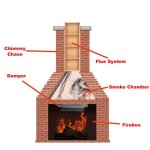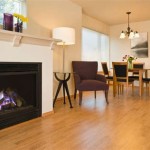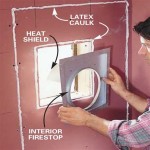Shelves Around Fireplace Ideas: Integrating Form and Function
Fireplaces have long served as focal points in living spaces, providing warmth and a sense of comfort. Integrating shelving around a fireplace enhances both its aesthetic appeal and functional utility. Thoughtful design and execution are crucial to creating a cohesive and visually pleasing arrangement that complements the existing décor and maximizes storage or display space.
The decision to incorporate shelves around a fireplace requires consideration of several factors, including the fireplace’s architecture, the room's dimensions, the desired style, and the intended purpose of the shelving. This article explores various ideas for integrating shelves around a fireplace, highlighting key considerations and design principles.
Assessing the Fireplace and Surrounding Space
Before embarking on a shelving project, a thorough assessment of the fireplace and surrounding area is essential. This involves evaluating the fireplace's existing structure, including its material (brick, stone, wood, or metal), its dimensions, and any existing architectural details. The dimensions of the wall space flanking the fireplace are equally important, as they dictate the available area for shelving units.
The style of the fireplace significantly influences the design of the surrounding shelves. A traditional brick fireplace often benefits from classic, built-in shelving with ornate detailing, while a modern, minimalist fireplace may be better suited to sleek, floating shelves with clean lines. The existing décor of the room should also guide the selection of materials and finishes for the shelves to ensure a harmonious and integrated look.
Consideration must be given to the functionality of the shelving. Will it primarily serve as a display area for decorative items, a storage solution for books and media, or a combination of both? The intended use will influence the depth, height, and configuration of the shelves. Furthermore, it is crucial to adhere to local building codes and safety regulations, particularly those related to clearances around a fireplace to prevent fire hazards.
Exploring Different Shelving Styles and Configurations
Several shelving styles and configurations can be employed to enhance a fireplace. Built-in shelves offer a seamless and integrated look, appearing as an extension of the fireplace itself. These are typically custom-designed and constructed to fit the specific dimensions of the space, providing a cohesive and tailored appearance. Built-in shelves are often installed floor-to-ceiling, maximizing storage and display capacity.
Floating shelves, on the other hand, provide a more contemporary and minimalist aesthetic. These shelves are mounted directly to the wall without visible supports, creating a clean and streamlined look. Floating shelves are ideal for displaying lightweight decorative items and can be arranged in various configurations to create visual interest. However, their weight-bearing capacity is typically lower than that of built-in shelves.
Another option is freestanding shelving units, which offer flexibility and portability. These units can be easily moved and rearranged as desired, making them suitable for individuals who prefer to change their décor frequently. Freestanding shelves come in a wide range of styles, materials, and sizes, allowing for customization to match the existing décor. However, they may not provide the same seamless integration as built-in or floating shelves.
The configuration of the shelves can also vary widely. Symmetrical arrangements, with shelves mirroring each other on either side of the fireplace, create a balanced and formal look. Asymmetrical arrangements, with shelves of varying heights and depths, offer a more dynamic and contemporary aesthetic. Open shelving, without doors or drawers, allows for easy access to displayed items, while closed shelving, with doors or drawers, provides concealed storage for less aesthetically pleasing items.
Materials, Finishes, and Detailing
The selection of materials and finishes for the shelves is crucial to achieving a cohesive and visually appealing look. Wood is a popular choice for shelving, offering warmth, versatility, and durability. Different types of wood, such as oak, maple, cherry, and pine, provide varying grain patterns and color tones. The wood can be stained, painted, or left natural to match the existing décor.
Metal shelving provides a more industrial and contemporary aesthetic. Steel, iron, and aluminum are common choices, offering strength and durability. Metal shelves can be powder-coated in various colors to customize their appearance. Glass shelves offer a sleek and modern look, allowing light to pass through and creating a sense of openness. However, glass shelves are more fragile and require careful handling. MDF (Medium-Density Fiberboard) is a cost-effective alternative to solid wood. It can be painted or veneered to mimic the look of natural wood.
The finish of the shelves significantly impacts their overall appearance. A matte finish provides a subtle and understated look, while a glossy finish offers a more polished and reflective appearance. Distressed finishes, with intentional imperfections and wear patterns, create a rustic and vintage aesthetic. The detailing of the shelves can also enhance their visual appeal. Decorative moldings, trim, and hardware can add character and personality to the shelving units. Consider incorporating built-in lighting, such as recessed lights or LED strips, to highlight displayed items and create a warm and inviting ambiance.
The color of the shelves should complement the fireplace and the surrounding room. Neutral colors, such as white, gray, and beige, are versatile and can be easily integrated into various décor styles. Bold colors, such as black, navy, or emerald green, can create a striking focal point. The use of contrasting colors can also add visual interest. For example, dark shelves against a light-colored wall can create a dramatic effect.
Planning and Execution
Careful planning and execution are essential for a successful shelving project. Begin by creating detailed sketches or digital renderings of the proposed shelving design. These visual aids will help to visualize the final outcome and identify any potential issues. Take accurate measurements of the fireplace and surrounding wall space to ensure that the shelves will fit properly. Consider the placement of electrical outlets and other utilities to avoid obstructions during installation.
Select the appropriate materials and finishes based on the desired style and functionality. Purchase high-quality materials to ensure durability and longevity. If building the shelves yourself, use appropriate tools and techniques to ensure accurate cuts and secure assembly. If hiring a professional contractor, obtain multiple quotes and check references to ensure qualified and reliable workmanship.
Before installing the shelves, prepare the wall surface by cleaning and patching any imperfections. Ensure that the wall is level and structurally sound to support the weight of the shelves and their contents. Use appropriate mounting hardware, such as wall anchors and screws, to secure the shelves to the wall. Consider hiring a qualified electrician to install any built-in lighting.
Once the shelves are installed, carefully arrange the displayed items to create a visually pleasing and balanced composition. Avoid overcrowding the shelves, and leave some empty spaces to allow the eye to rest. Arrange items of varying heights and sizes to add visual interest. Use decorative objects, such as books, vases, picture frames, and sculptures, to personalize the shelves. Regularly dust and clean the shelves to maintain their appearance.
Integrating shelves around a fireplace requires careful planning, thoughtful design, and precise execution. By considering the fireplace's architecture, the room's dimensions, the desired style, and the intended purpose of the shelving, one can create a cohesive and visually appealing arrangement that enhances both the aesthetic appeal and functional utility of the living space. The selection of appropriate materials, finishes, and detailing is crucial to achieving a harmonious and integrated look. With careful planning and execution, shelves around a fireplace can transform a living space into a warm, inviting, and functional environment.

Four Easy Tips For Decorating Built In Shelves Our Hammock House

Bluehost Com Floating Shelves Living Room Remodeling

Bookshelves Around Fireplace Design Ideas

Best Built In Bookshelves Around A Fireplace Design Ideas Shelves Living Room Renovation Decor

White Built In Bookshelves Around The Fireplace Green With Decor

Four Easy Tips For Decorating Built In Shelves Our Hammock House

Fireplace Floating Shelves Design Ideas

8 Secrets To Successfully Styling Bookcases And Built Ins

8 Secrets To Successfully Styling Bookcases And Built Ins

10 Stunning Ideas For Built Ins Around A Fireplace Jenna Kate At Home
Related Posts








